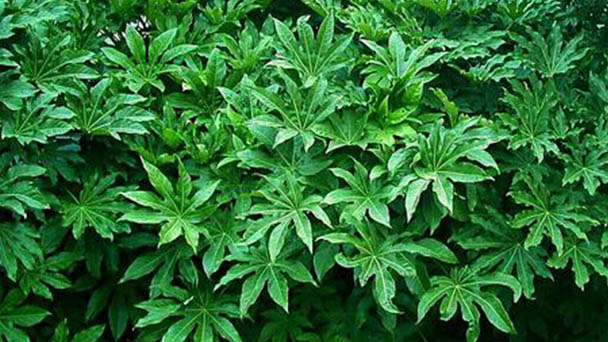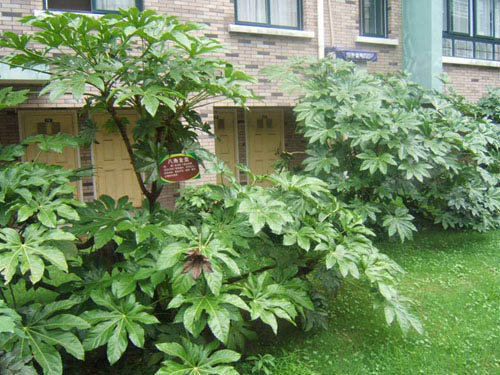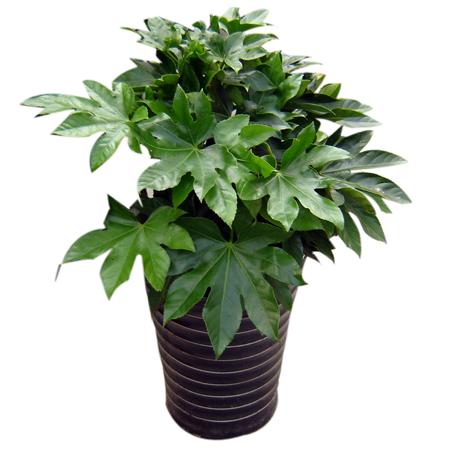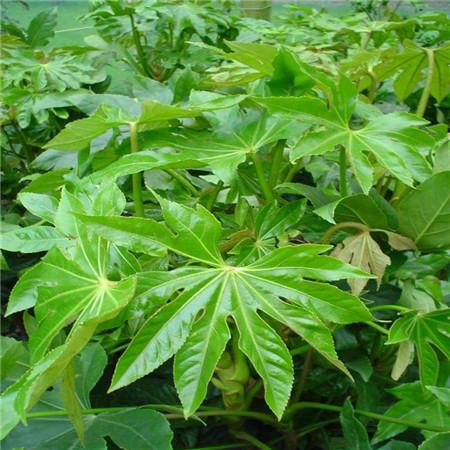Japanese Aralia (Fatsia Japonica) Profile: Plant Info, Care & Propagation Guide
Written by Maggie
Dec 07 2021

Japanese Aralia (Fatsia japonica), also known as glossy-leaf paper plant, fatsi, paperplant, false castor oil plant, or Japanese Aralia, is a palmate-shaped leaf, with about eight lobed leaves that appear to have eight horns. Japanese Aralia usually blooms between summer and fall, and sometimes into late autumn and early winter, with beautiful white cone-shaped cymes at the end, followed by blackberries and seeds. Japanese Aralia is a strong negative plant that is green in all seasons and can be used indoors all year round.
Japanese Aralia Picture

Japanese Aralia Info
| Botanical Name | Fatsia japonica |
| Common Names | Japanese Aralia, Spider's web, Glossy-leaved paper plant, False castor oil |
| Plant Type | Shrub |
| Sun | Partial sun, shade |
| Hardiness Zones | 7 to 9 (USDA) |
| Flower color | White |
| Native Area | Asia |
| Mature size | 4–5 ft. tall, 3–4 ft. wide |
Japanese Aralia Characteristics
Japanese Aralia Stems
Japanese Aralia is an evergreen shrub or small tree, up to 5m tall. The stem is smooth and spiny.
Japanese Aralia Leaf
Petiole of Japanese Aralia is 10 -- 30cm long; Leaves are large, leathery, suborbicular, 12-30cm in diameter, palmately 7-9 deeply lobed, lobes long elliptic ovate, apex shortly acuminate, base cordate, margin coarsely serrate, upper surface dark bright green, lower complexion lighter, granular protuberance, margin sometimes golden yellow; Lateral pulse bulges on both sides, reticulate veins slightly prominent below.
Japanese Aralia Flowers
Japanese Aralia terminal panicle is 20 -- 40cm long; Inflorescences are 3 -- 5cm in diameter, rachis brownish tomentose; Calyx is subentire, glabrous; japanese aralia has 5 petals, ovate-triangular, 2.5 -- 3mm long, yellow-white, glabrous; Japanese Aralia has 5 stamens, filaments equal to petals length; Ovary is inferior, 5-locule, with 1 blastomere in each locule; Japanese Aralia has 5 styles, detached; Disk convex semicircle.
Japanese Aralia Fruit
The fruit of Japanese Aralia is subglobose, 5mm in diameter, black when ripe.
Japanese Aralia Habits
Japanese Aralia is native to the forests and mountains near the warm seas of Japan. Introduced in the early years of our country, Japanese Aralia is now widely cultivated in the south of the Yangtze River area, for urban afforestation and garden viewing, especially in Taiwan. For the subtropical tree species, Japanese Aralia likes damp and warm climate. Japanese Aralia can't stand drought, can't stand cold. It is advisable to plant in an area with a good microclimate, preferably in the well-drained and fertile slightly acidic soil, and also in the neutral soil. The tillering ability is strong.
Japanese Aralia likes wet, warm and humid climates. It is tolerant of shade and drought and has a certain cold tolerance. It is advisable to plant in sandy loam with good drainage and moisture.
Japanese Aralia Distribution
Japanese Aralia is native to the Ryukyu Islands. It was introduced in Taiwan and is now widely cultivated in warm areas of the world.
Japanese Aralia Care
Japanese Aralia Fertilizing & Watering
When Japanese Aralia grows vigorously from April to October, thin liquid fertilizer should be applied every two weeks or so. Fertilization should be stopped after October. In summer and autumn high-temperature season, to water, and pay attention to the leaf and the surrounding space water, in order to improve the air humidity.
Japanese Aralia Light & Temperature Care
Japanese Aralia prefers cold and cool environments and grows at a temperature of about 10~25℃. It is a semi-negative plant and avoids strong sunlight. Greenhouse cultivation, winter should be more sunshine, spring, summer and autumn should be shaded more than 60%, such as a short time of direct sunlight in summer, sunburn may also occur. Long-term lack of light, the leaves will become small. In April, after going out of the room, it should be conserved in a shade shed or under a tree. Japanese Aralia grows well indoors at 18~20℃ during the day and 10~12℃ at night. Long time high temperature, the leaf becomes thin and large, easy to sag. The overwintering temperature should be kept above 7℃.
Japanese Aralia Soil & Repotting
Turn the soil and change the basin once every 1 to 2 years, usually in spring. When tilting for the basin, the basin bottom should be put into the base fertilizer. Basin soil can be humus or peat soil 2, plus river sand or perlite 1, can also be cultivated fine sand.
Repotting Because Japanese Aralia can grow to be so large, keeping an eye on its pot is important. Once the plant is showing signs of outgrowing its vessel (like roots growing out of the drainage holes), or at least once a year, replant your Japanese Aralia in a larger pot.Read Next: Japanese Aralia Care in Detail

Japanese Aralia Propagation
Japanese Aralia can be propagated by cuttings, sowing, and splitting.
Japanese Aralia Propagation from Cutting
Usually, the use of cutting propagation, spring sowing in the first year in spring, autumn inserted in August, choose biennial hard branches, cut into 15cm long cuttings, inserted into the sand bed 2/3, moisture, and plastic arch shed closed, shade. In summer, cuttings were used to maintain temperature and shade and properly ventilated. After taking root, the arch shed was removed and the shade shed was retained. Sowing, seed in April, stacked after cooked, washed seeds, dry can sow or mix sand layer, put the cellar storage, the next spring sowing. After sowing cover grass moisture, 1 month or so germination unearthed, to the grass after spraying moisture, autumn cold, leaving a bed for 1 year can be transplanted. Divide the Japanese Aralia, before spring germination, dig into the roots of the seedlings sprout and transplant with soil.
Japanese Aralia Propagation from Seed
Seeds of Japanese Aralia are collected in spring, piled up after harvest, cooked, washed and sown at the pick. The average germination rate of seeds is 26.3%, which is low. Therefore, seeding at the pick is not ideal for Japanese Aralia. Because Japanese Aralia fruits are berries, seeds have high water content, and a layer of mucus is attached to the surface of freshly washed seeds, which prevents oxygen from entering the seeds, causing hypoxia, and tends to mold the seeds, leading to a decline in seed germination rate. And after in order to overcome these shortcomings, the seeds of air-dried 5, 15, 25 d after seed germination rate were 60.0%, 75.3% and 51.0% on average, the seed germination rate increases with the increasing mining increased by 33.7%, 49% and 24.7% respectively, if cannot the sowing seeds, natural dry storage of seed germination rate was 18.5%, dry storage refrigerator seed germination rate of 48.7%, refrigerator dry seed germination rate of the dry naturally, hidden seeds germination rate increased by 30.2%; The results showed that the life span of Japanese Aralia seeds dried in the refrigerator was relatively prolonged, and the germination rate was also improved to some extent. Before sowing, you should first build a shade shed, sprout 1 month after sowing, uncover grass in time, keep the bed soil moist, winter seedlings need to prevent drought, leave the bed for a year or planting, breeding ground to choose shade and moist place of the open land cultivation, need to build a shade shed;
Japanese Aralia Propagation from Division
Combined with the spring pot change, the Japanese Aralia full of pot from the pot out, prune the roots of poor growth and then cut the original plant cluster into several clusters or several plants, plant to the size of the appropriate pot, placed in the ventilated and cool place for conservation, 2~3 weeks can be transferred to normal management. Subdivision propagation should be followed by subdivision to improve the survival rate.
Japanese Aralia Disease & Pest control
The main diseases of Japanese Aralia are bituminous coal disease, leaf spot disease, and chlorosis. Water and fertilizer management and ventilation should be strengthened during conservation, especially in winter, when opening Windows for ventilation. If disease occurs, bituminous coal disease should be wiped away with clean cotton cloth in time, and spray chlorothalonil and other bactericidal drugs for prevention and control; Leaf spot disease in summer, such as the occurrence of methyl tobujin or carbendazim and other agents for prevention and control; Chlorosis can be controlled by foliar spraying with aqueous ferrous sulfate.
The main pests of Japanese Aralia are aphids, scale insects, and red spiders. Rapid mesenchysis is used to control scale insects, aphids are controlled with aphids, and red spiders are controlled with dichlorophenol.
Japanese Aralia Species Classification
Japanese Aralia main cultivars are:
(1) Japanese Aralia with white spots on the leaves;
(2) Japanese Aralia, with yellow spots on its leaves;
(3) Japanese Aralia, with fine yellow lines on leaves;
(4) Japanese Aralia, palmately deeply lobed, lobes subdivided;
(5) Japanese Aralia, white;
(6) margin Japanese Aralia, leaf margin undulate, wrinkled;
(7) dwarf Japanese Aralia, short in height, dense in foliage, and vigorous in growth.
Japanese Aralia uses
Garden use of Japanese Aralia
Japanese Aralia is evergreen with large leaves, a beautiful leaf shape, dark green light, is a popular indoor foliage plant. Adapt to indoor weak light environment, for hotels, restaurants, office buildings and family beautification commonly used plant materials. Japanese Aralia is used to decorate the hall, window sill, corridor, poolside, or as the substrate of the indoor flower bed. The leaf is also a good match for flower arrangement. In the south of the Yangtze River basin, it can be used in the open field and should be planted in the garden, corner and shady part of the building. Japanese Aralia also can adorn in the stream, pool or group under the forest, the grass side.
Japanese Aralia is an excellent foliage plant. Japanese Aralia also can be potted for indoor ornamental.
Absorption of harmful gases
Japanese Aralia can absorb harmful gases such as carbon dioxide in the air and purify the air. In the house that modern lives, a lot of people often door window is closed, let the air in the home and the air outside be ventilated rarely, the harmful gas that the human body inside the home exhales is discharged to wait a moment outside the house. And when these harmful gases are accumulated to a certain amount in the room, the indoor air will become more and more turbid. In addition, the air quality in cities is getting worse and worse. If Japanese Aralia is planted at home, it can absorb some harmful gases such as carbon dioxide, purify the air and make the owner's life more comfortable.
Green indoor environment
Japanese Aralia is an ornamental plant that is evergreen all year round and produces elegant flowers. Growing a Japanese Aralia indoors is a good way to make your environment green. There is no need to spend a lot of effort inbreeding, it will be kept in the courtyard, door, window, wall corner and the shade of the building can be, the owner can also appreciate its green appearance at any time. (Read More about Fatsia Japonica Indoors Care.)
Medical use
Japanese Aralia can promote blood circulation and remove blood stasis. Reducing phlegm and relieving cough; Wind dehumidification; Removing stasis and relieving pain. The main cure falls injury. Cough phlegm; Rheumatism arthralgia; Gout.
Japanese Aralia Toxicity
Japanese Aralia is poisonous, and can cause immune system poisoning and mental sex poisoning, organ damage sex poisoning.
One case caused a level 1 disability after taking the drug. He was sick in bed all year round, and his stomach was distended, which was very painful.

Latest Updated
- Benefits of Bugleweed - 7 Science-backed Health Benefits
- Bugleweed Dangers & Side Effects - Is It Poisonous?
- How to Plant Evergreen Trees - What You Should Know
- When to Plant Evergreens - Grow Guide for Evergreen Trees
- 12 Wonderful Evergreen Shrubs for Your Garden
- 12 Popular Evergreen Plants with Pictures for Beginners
- When And How To Prune A Lilac Bush Like a Pro
- How to Grow & Care for Lilac Vine (Hardenbergia Violacea)
- Japanese Lilac Tree (Syringa Reticulata) Care & Propagation Guide
- Shumard Oak Pros and Cons - What to Know
Popular Articles
- Winter maintenance of Antirrhinum Majus
- How to Grow Terminalia Mantaly Tree
- How to Grow and Care for Crossostephium Chinense
- How to grow Antirrhinum Majus in spring
- Peristeria Elata (Dove Orchid) Profile: Info & Care Guide
- Underwatered Snake Plant (Sansevieria Trifasciata) - Signs And How To Fix
- How to Care for Brazilian Jasmine Plant (Mandevilla Sanderi)
- How to Grow & Care for Graptopetalum Purple Delight in Summer
- Rosa Chinensis (China Rose): Plant Growing & Care Tips
- How to Care for Baby Sun Rose (Aptenia Cordifolia)